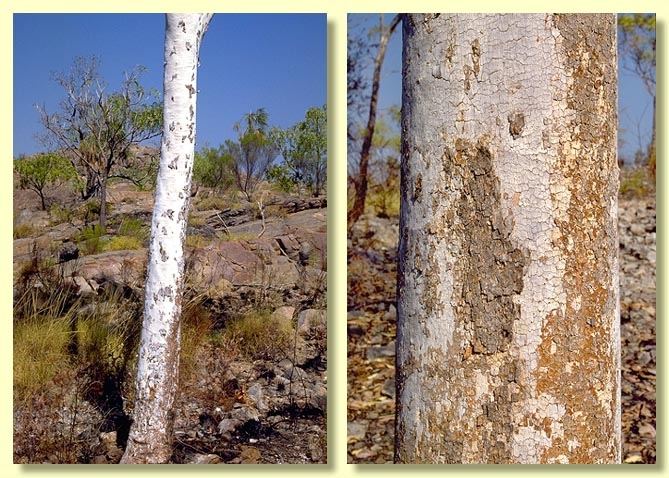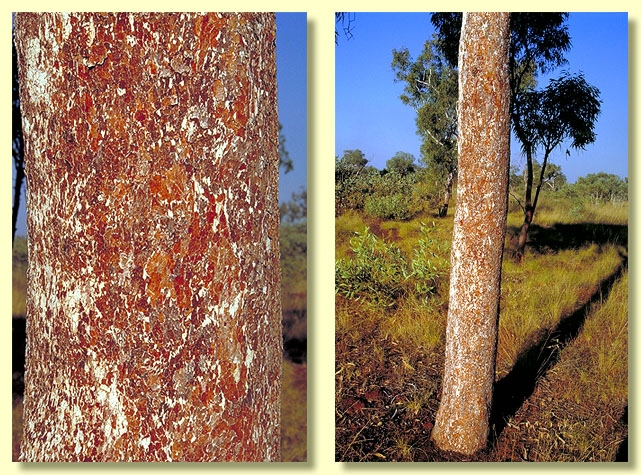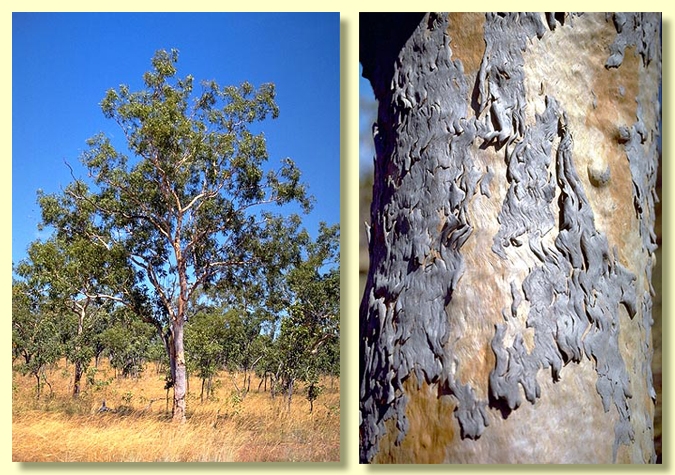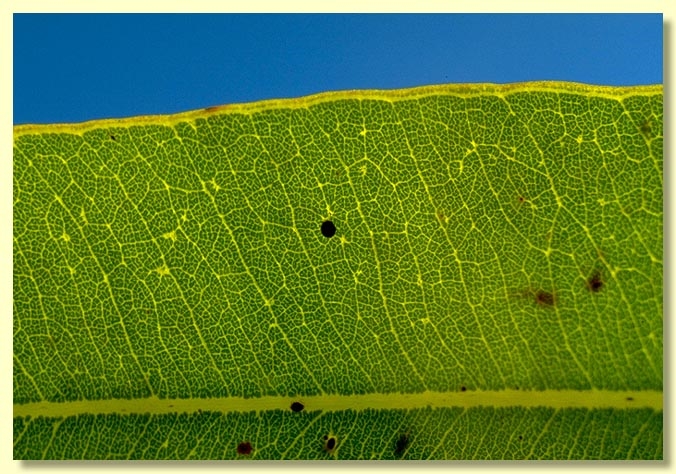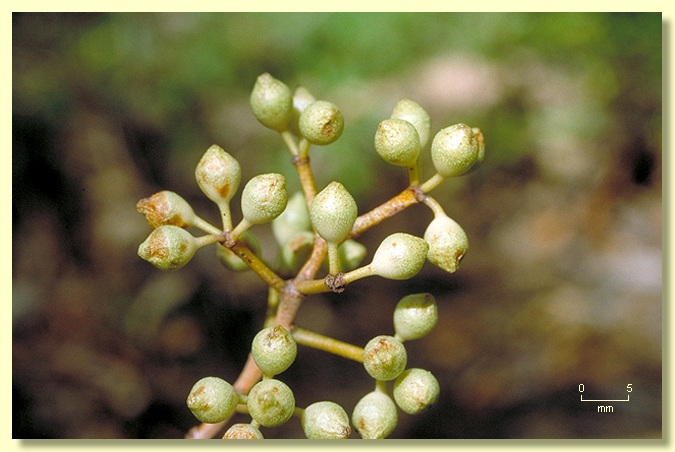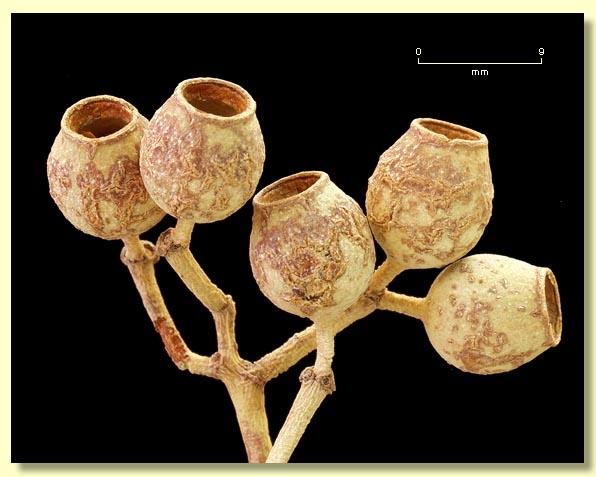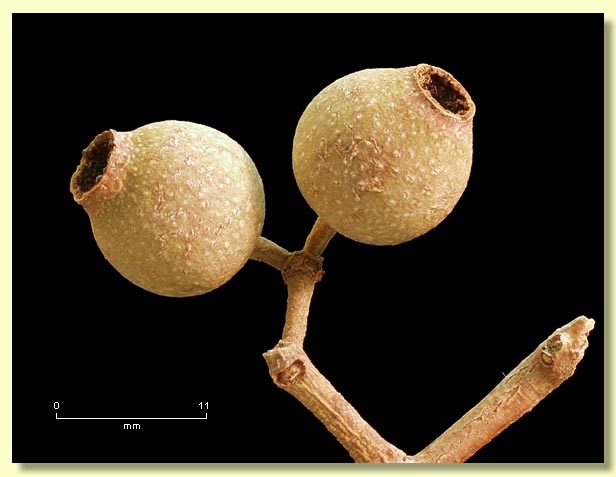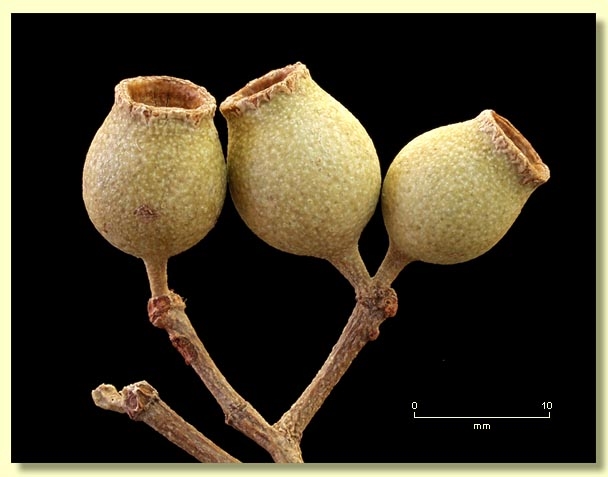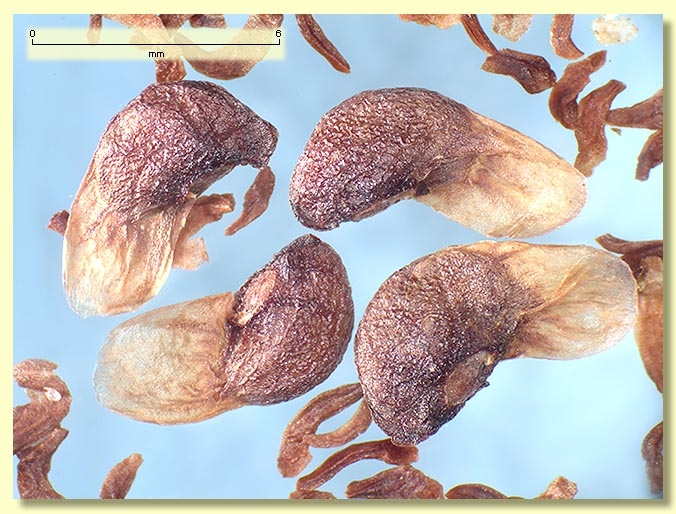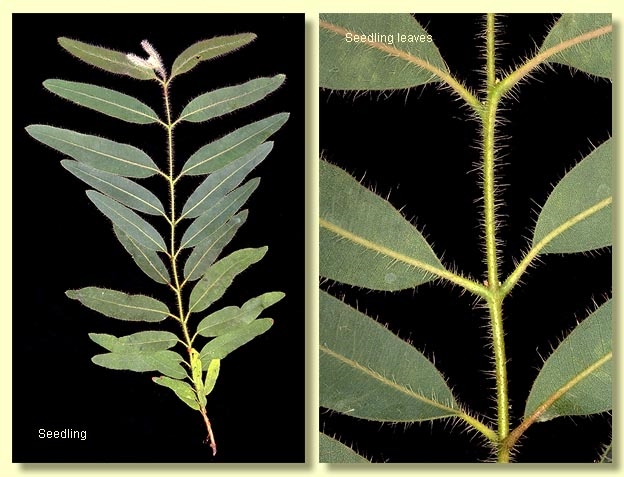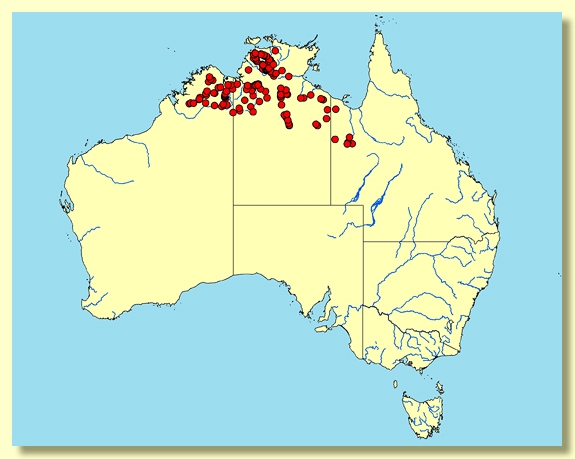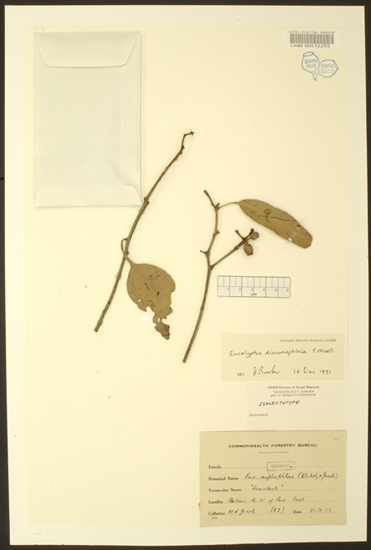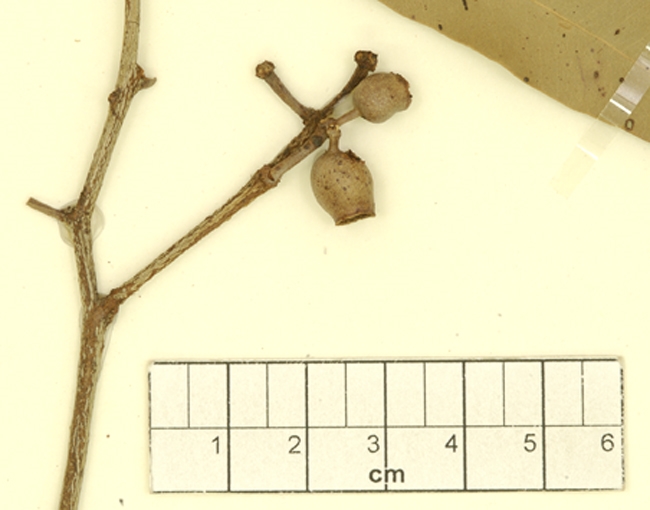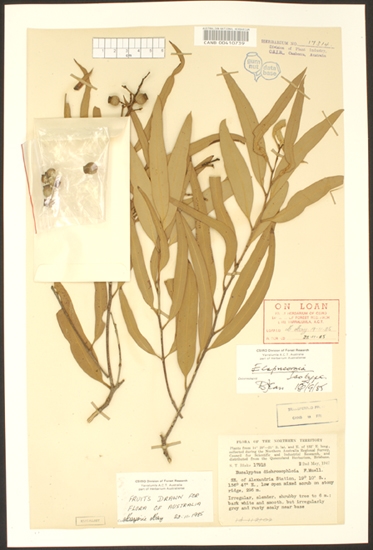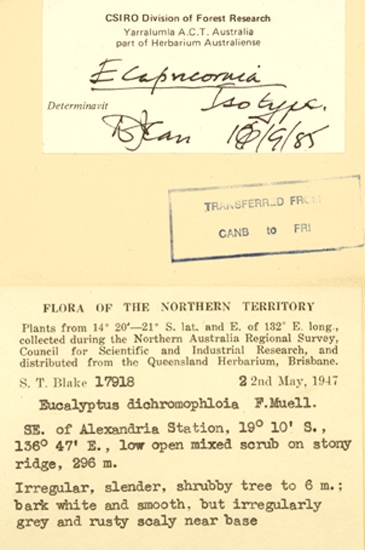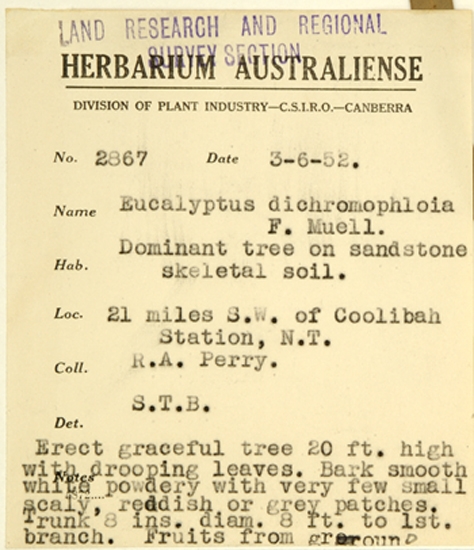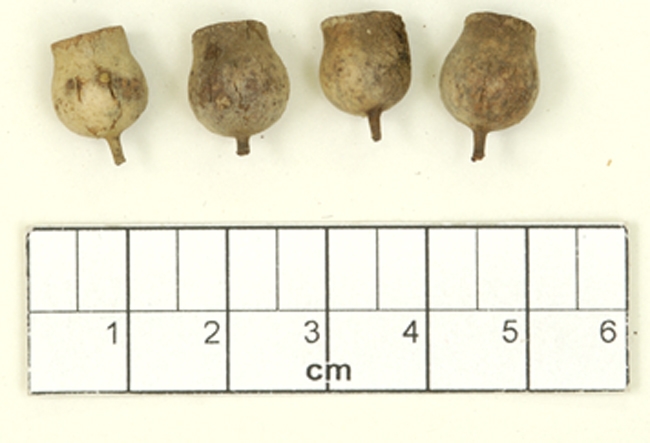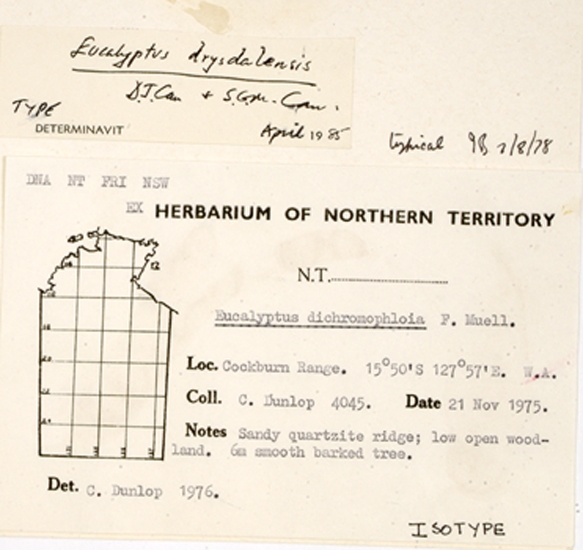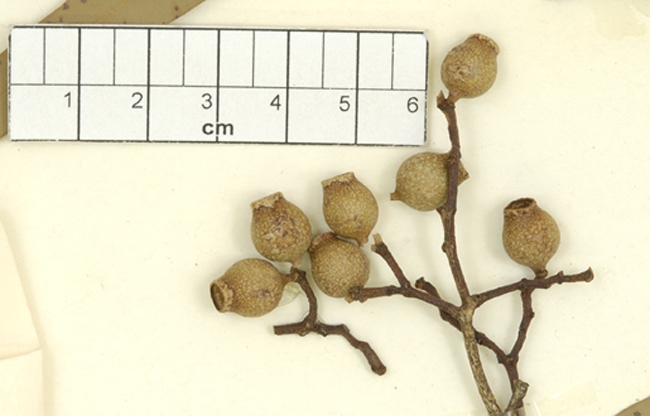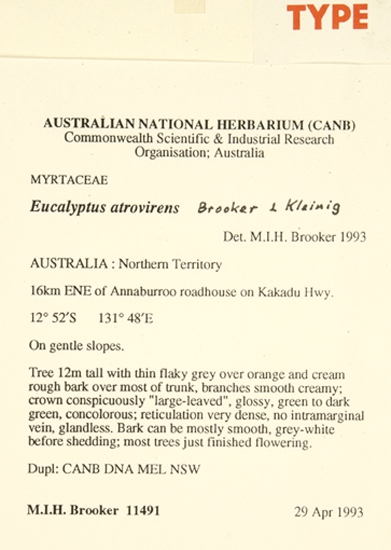Euclid - Online edition
Corymbia dichromophloia
Corymbia | Rufaria
Corymbia dichromophloia (F.Muell.) K.D.Hill & L.A.S.Johnson, Telopea 6: 295 (1995).
Eucalyptus dichromophloia F.Muell., J. Linn. Soc., Bot. 3: 89 (1859). T: Northern Territory: in rocks of the Fitzmaurice Ranges, Oct. 1855, F.Mueller s.n.; lecto: MEL; isolecto: K, NSW.
Corymbia rubens K.D.Hill & L.A.S.Johnson, Telopea 6: 301 (1995). T: Western Australia: 83.6 km W of Durack River on Wyndham - Gibb River road (16°06'S 126°34'E), 19 Nov. 1988, K.D.Hill 3385, L.A.S.Johnson & L.Stanberg; holo: NSW.
Eucalyptus capricornia D.J.Carr & S.G.M.Carr, Eucalyptus 1: 100 (1985); Corymbia capricornia (D.J.Carr & S.G.M.Carr) K.D.Hill & L.A.S.Johnson Telopea 6: 299 (1995). T: Northern Territory: SE of Alexandria Station, 19º10'S, 136º47'E, low open mixed scrub on stony ridge, 22 May 1947, S.T.Blake 17918; holo: BRI 110321; iso: CANB.
Eucalyptus atrovirens Brooker & Kleinig, Field Guide to Eucalypts, Volume 3, Northern Australia. Edn. 1.: 86, 371 (1994). T: Northern Territory, 16 km ENE of Annaburroo roadhouse on Kakadu Highway (12°52'S, 131°48'E), 29 April 1993, M.I.H.Brooker 11491 & D.A.Kleinig; holo: CANB; iso AD, CANB, DNA, MEL, NSW.
Tree to 15 m tall. Forming a lignotuber.
Bark essentially smooth, white and seasonally powdery throughout but with unshed thin, orange, red and brownish flakes of bark over the base and scattered up the trunk. Not truly rough-barked at the base in most populations, but sometimes thinly accumulated rough bark may cover part of trunk.
Branchlets lack oil glands in the pith; non-glaucous but in some populations in west of species range a white rubbery cuticle is obvious on new branchlets.
Juvenile growth (coppice or field seedlings to 50 cm): stems rounded in cross-section, scabrid with bristle-glands at least in the lower part but upper internodes becoming smooth; juvenile leaves always petiolate, opposite for ca 15 or so nodes then becoming alternate, large, ovate to broadly lanceolate, sometimes ± deltoid or elliptical, (6)9.5–22(28) cm long, 5.5–10(15) cm wide, base rounded to tapering or less commonly truncate or shallowly lobed, apex rounded and apiculate or pointed, green, lower leaves scabrid with bristle-glands, upper leaves less so or smooth; short white simple hairs sometimes present on leaf lower surface, much shorter than the bristle-glands.
Adult leaves alternate, petioles 0.9–3.4 cm long; blade lanceolate or falcate, 7–23 cm long, 0.8–5.5 cm wide, base tapering to petiole, margin entire, apex pointed, concolorous or only slightly discolorous, dull or slightly glossy, green, smooth, side-veins at greater than 45° to midrib (penniveined), reticulation very dense, intramarginal vein apparently absent (confluent with margin) or rarely visible and very close to margin in broader leaves, oil glands not visible.
Inflorescence terminal compound, peduncles terete or slightly angular, 0.1–1.7 cm long, buds usually 7 per umbel, rarely 9 or more, pedicels 0.1–1.1 cm. Mature buds ovoid or obovoid to pyriform or globular, 0.4–0.7 cm long, 0.3–0.5 cm wide, smooth and glossy, scar absent (both opercula shed together at flowering), operculum shallowly rounded and apiculate or not so, stamens inflexed, all fertile, anthers oblong, dorsifixed, versatile, dehiscing by longitudinal slits, style as long as the floral cavity or ca two-thirds the length, straight, stigma blunt or with a fringe of papillae, locules 3 or 4, the placentae each with ca 5 vertical ovule rows or the rows indistinct. Flowers creamy white.
Fruit pedicellate (pedicels 0.1–0.7(0.9) cm long), usually urceolate or tending to barrel-shaped, with a short neck that is flared at the rim, 0.8–1.3(1.8) cm long, 0.6–1.1(1.5) cm wide, smooth, disc descending vertically, valves 3 or 4, enclosed.
Seeds brown, 5–9(11) mm long, ellipsoidal with terminal wing, hilum ventral.
Cultivated seedlings (measured at ca node 10): cotyledons large, reniform; stems rounded in cross-section, setose with long bristle-glands; leaves always petiolate (petioles to 0.7 cm), opposite for at least 13 nodes, elliptical-oblong to lanceolate or ovate, 3–12(16) cm long, (0.7)1–3.6 cm wide, base rounded to tapering, rarely truncate or lobed, apex pointed or rounded, green, slightly discolorous or concolorous, setose with bristle-glands on both surfaces but especially on margins and midrib.
Flowering has been recorded in February, March, April, May, July and August.
A woodland tree common in monsoonal Australia, in the western Top End of the Northern Territory extending south to Katherine, west through the Victoria River region into Western Australia where found sporadically in the Kimberley Region, in the Durack Range, Phillips Range and King Leopold Range. It also extends east through the Barkly Tableland into Queensland occurring on hills in the Wollogorang, Mount Isa and Cloncurry areas, as far as Mount Fort Bowen, south of Normanton. It usually occurs on shallow soils on ridges and slopes and around the edges of mesas, on substrates of granite, sandstones and laterite. Corymbia dichromophloia is characterised by its smooth white powdery bark with scattered thin flakes of red bark, especially on the basal trunk; small smooth buds; small urn-shaped fruit rarely more than 1 cm wide and adult leaves that lack an obvious intramarginal vein; juvenile leaves that are relatively large, ± ovate and at lower nodes setose/scabrid.
In EUCLID the current editors take a broad view of C. dichromophloia, including in it six species described since 1934 by various botanists (see nomenclature above). Our rationale is simply that we cannot consistently distinguish the taxa morphologically in the field, or the herbarium, nor as seedlings grown to the 10 node stage in comparative conditions. Particular note should be made here of two of these synonymized species names viz. Corymbia capricornia and C. drysdalensis. Both are applied to plants that occur in the seasonally drier part of the geographic range and have consistently narrow-leaved crowns lacking the any broader, retained intermediate leaves often found persisting in the otherwise narrow-leaved crowns of C. dichromophloia (sensu stricto) in parts of the Top End of the Northern Territory. Interestingly Corymbia capricornia and C. drysdalensis as originally described differ only in the presence or absense of visible white rubbery cuticle on newly forming leaf growth and stems - white new growth highly visible in C. drysdalensis and absent in C. capricornia. Populations of trees for example west of Timber Creek in the Northern Territory appear to be very variable in expression of this character with some plants lacking it, some slightly visibly white and others strongly so, yet all may be in bud at the same time. Further west e.g. in the Phillips Range in the Kimberley region all plants seem to express the character strongly i.e. are white-tipped in the growing season. On the hills around Mount Isa all plants lack a visible white cuticle on new growth. The seeming variability in expression of this cuticle character, coupled with the lack of other strong discriminating features lead the authors of EUCLID to include Corymbia capricornia and C. drysdalensis in a broad concept of C. dichromophloia. (It is interesting to note that in the collection of the Northern Territory Herbarium (DNA) Corymbia capricornia is synonymized under the name C. drysdalensis and that C. dichromophloia is maintained as a separate taxon endemic to the Top End because of its slightly broader leaves).
Throughout the geographic range other predominantly white-barked or scaly-barked bloodwood species may superficially appear similar to C. dichromophloia: C. oocarpa, C. bleeseri, C. collina, C. umbonata, C. greeniana. But differences are clear as outlined below.
C. dichromophloia is difficult to distinguish from C. oocarpa, a species endemic to the escarpments of Arnhem Land, but the latter has consistently glossy green leaves in which the intramarginal vein can often be seen distinct from the margin, juvenile leaves always < 4 cm wide and fruit more barrel-shaped than urn-shaped. C. dichromophloia seems to be absent from these elevated sandstone areas of Arnhem Land. C. bleeseri clearly differs in having very glossy green adult leaves with visible intramarginal vein and larger, longer barrel-shaped fruit, and is restricted to generally wetter more northern areas of the Top End and Kimberley regions than C. dichromophloia. C. collina also has highly glossy adult leaves which have a whitish rubbery cuticle when newly formed, giving the crown a temporary "silvery" appearance when in a growth flush, but has much larger barrel-shaped fruit always > 1.8 cm wide and barrel-shaped. C. umbonata has very similar adult leaves and buds to C. dichromophloia, and slightly larger fruit, but differs most noticeably in the bark, which is thinly rough/scaly over the trunk and usually the larger branches. C. umbonata is found between Larrimah, Katherine and Willeroo in the Northern Territory, i.e. within the range of C. dichromophloia but as a taller tree on deeper sandy soils. C. greeniana also may look very superficially like C. dichromophloia but generally has broader adult leaves and slightly larger fruit (1.1–2.2 cm wide) on longer pedicels and, most noticeably, thinly tessellated to flaky rough bark on the base of the trunk at least.
Other whitish-barked species of bloodwood growing within the range of C. dichromophloia are C. latifolia and C. foelscheana, both of which differ in having broad adult leaves that are deciduous in the dry season, thinly persistent rough coarsely tessellated bark at least on the lower trunk, and juvenile leaves larger than those of C. dichromophloia. C. foelscheana has fruit 1.4–2.4 cm wide, whilst those of C. latifolia are similar to those of C. dichromophloia, being 0.7–1.3 cm wide.
Care must be taken when collecting juvenile (coppice) growth of C. dichromophloia as another bloodwood, the fully rough-barked C. porrecta, has similar robust juveniles and grows on similar sites. C. porrecta is well known for being rhizomatous and it produces large numbers of juvenile clumps. These leaves differ from C. dichromophloia in being glabrous (scabrid/setose on lowest leaves in the latter species). C. porrecta only occurs in the seasonally wetter more northerly areas of the Top End of the Northern Territory.
MORE ABOUT CORYMBIA
MORE ABOUT RED BLOODWOODS
Eucalyptus dichromophloia: Greek di, two and chromo, colour and phloia, bark, referring to the bark colour: white with red flakes.


